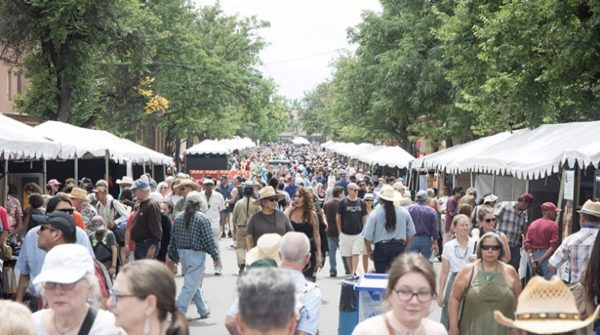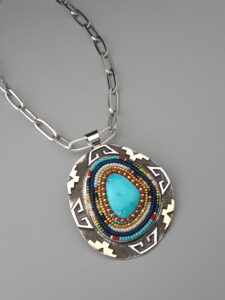
- Details
- By Native News Online Staff
SANTA FE, N.M. — The decision to shift August’s Santa Fe Indian Market into digital territory due to COVID-19 raised concerns that talented artists without online marketing skills may be at a disadvantage.
“We have several hundred artists who will be participating in the virtual market and they really run the gamut as far as technical savvy,” said Southwestern Association for Indian Arts (SWAIA) PR and Marketing Director Amanda Crocker. “Although some have an incredible web presence already and are rocking it, there are people who need help with digital marketing.”
To level the virtual playing field, Crocker conceived SWAIA’s new Artists Helping Artists Fellowship, a chance for indigenous multimedia professionals and experienced amateurs, including photographers, videographers, and web designers, to help artists maximize their online selling and storytelling power.
SWAIA will pay $1,200 each to four recipients, each of whom will assist at least six artists. Multimedia artists can also apply as a team for $2,400, in which case the assisted artist load will be doubled.
More information and the application can be found here or by emailing [email protected]. The deadline to apply is Tuesday, June 30. The virtual Market runs August 1-31.
That gives the multimedia artists a month to bring the artists and their work to life online.
“They could do anything from taking professional photographs of the work to sell on an artist’s e-commerce site, all the way up to doing a little mini documentary about that artist,” Crocker said. “SWAIA recognizes we don’t have all the answers to how this could be done, but these talented professionals might have fantastic ideas, so we want to open that opportunity to them as well to be creative and maybe try something different.”
Having a personal multimedia producer will be invaluable to veteran market artist LeJeune Chavez (Santo Domingo Pueblo.) She said she just joined Facebook in April to start building an online identity.
 Artists Joe and LeJeune Chavez look forward to digital marketing help for their wearable art, which features traditional Pueblo symbols, contemporary innovation and a singular technique they call "beads on silver." (Courtesy photo)
Artists Joe and LeJeune Chavez look forward to digital marketing help for their wearable art, which features traditional Pueblo symbols, contemporary innovation and a singular technique they call "beads on silver." (Courtesy photo)
“I tried to familiarize myself with social media stuff and I found someone to help with a website,” she said. “There are a lot of things I need to learn. (The Fellowship) is a great idea because I definitely am not an expert. I do need assistance.”
Chavez, a bead worker, said she already has a promotional project idea. She often collaborates with her silversmith husband Joe, and she wants her assistant to record video of the couple making art together.
This crisis-inspired chance for market artists and multimedia mavens to join forces opens up a world of virtual possibilities.
“I really have high hopes for some of the material we’re going to get back,” Crocker said. “Who knows what kind of collaborations and cross-community interactions there will be?”
The Artists Helping Artists Fellowship is replacing the Market’s annual $3,500 Discovery Fellowship, which is customarily awarded to two artists.
“With cuts in our budget and a need to really help artists through the COVID crisis, we decided to make a smaller amount of fellowship funds go farther by helping as many artists as possible,” Crocker said. “The Discovery Fellowship is simply on hold for now.”
Tamara Ikenberg is a contributing writer to Native News Online. She can be reached at [email protected].
More Stories Like This
Native News Weekly (August 25, 2024): D.C. BriefsUS Presidents in Their Own Words Concerning American Indians
Suspected Drunk Driver Crashes into Parade in Kayenta on Navajo Nation, Killing 1 & Injuring 3 Others
Tribal Broadband to Get $6.5M Boost as NTIA Plans Consultations
Pokagon Potawatomi Band, Four Winds Casinos Donate 1,000 Christmas Food Boxes
Help us defend tribal sovereignty.
At Native News Online, our mission is rooted in telling the stories that strengthen sovereignty and uplift Indigenous voices — not just at year’s end, but every single day.
Because of your generosity last year, we were able to keep our reporters on the ground in tribal communities, at national gatherings and in the halls of Congress — covering the issues that matter most to Indian Country: sovereignty, culture, education, health and economic opportunity.
That support sustained us through a tough year in 2025. Now, as we look to the year ahead, we need your help right now to ensure warrior journalism remains strong — reporting that defends tribal sovereignty, amplifies Native truth, and holds power accountable.
 The stakes couldn't be higher. Your support keeps Native voices heard, Native stories told and Native sovereignty defended.
The stakes couldn't be higher. Your support keeps Native voices heard, Native stories told and Native sovereignty defended.
Stand with Warrior Journalism today.
Levi Rickert (Potawatomi), Editor & Publisher

